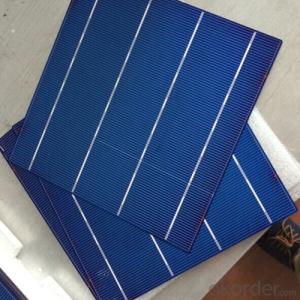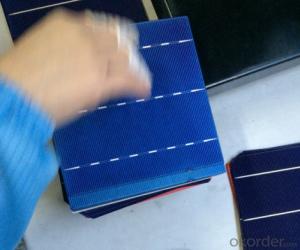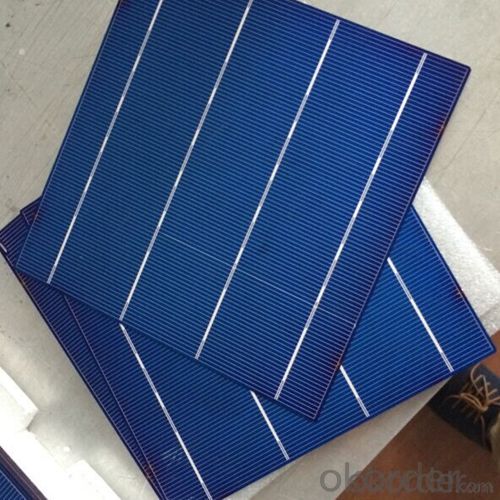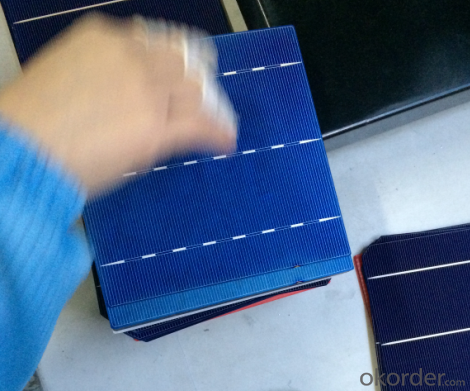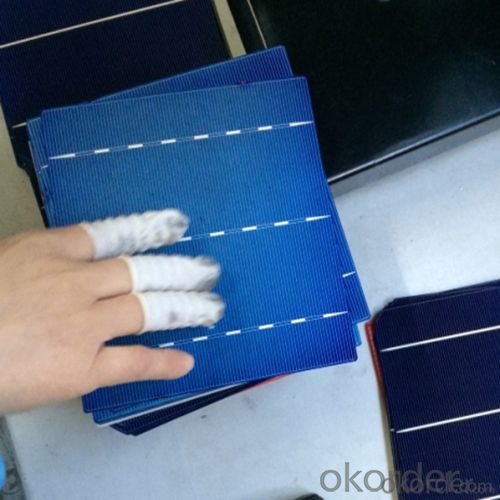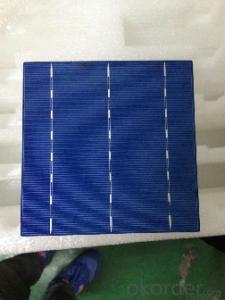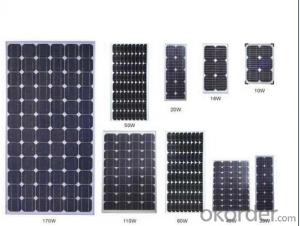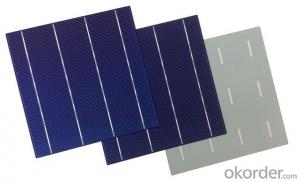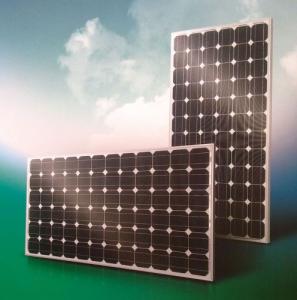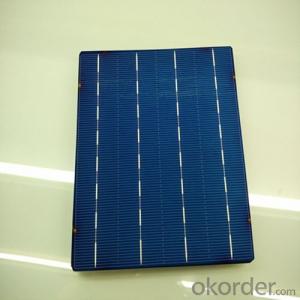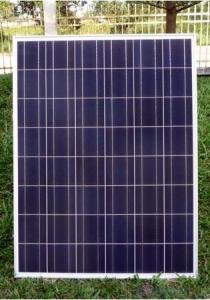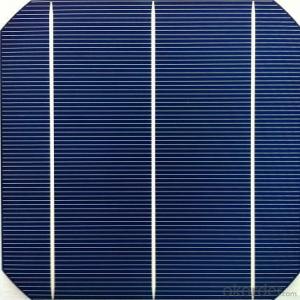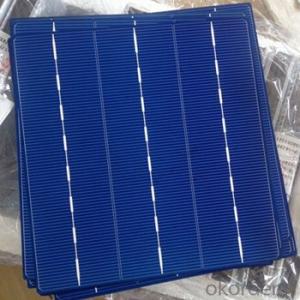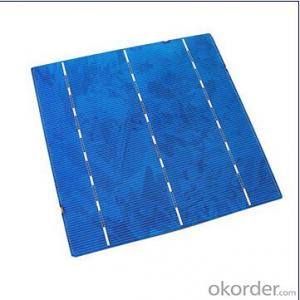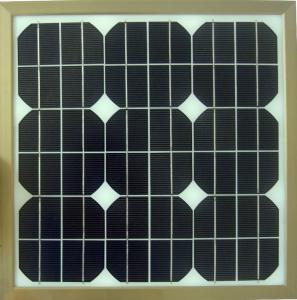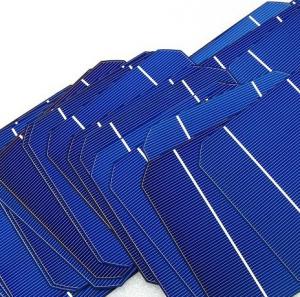Elon Musk Inspired Poly 3bb 4bb Solar Cells with Low Price 156*156mm
- Loading Port:
- Shanghai
- Payment Terms:
- TT or LC
- Min Order Qty:
- 30000 pc
- Supply Capability:
- 3000000 pc/month
OKorder Service Pledge
OKorder Financial Service
You Might Also Like
Product description
Poly Solar Cells 156*156mm B Grade Low Price 3BB 4BB
A solar cell, or photovoltaic cell, is an electrical device that converts the energy of light directly into electricity by the photovoltaic effect, which is a physical and chemical phenomenon.[1] It is a form of photoelectric cell, defined as a device whose electrical characteristics, such as current, voltage, or resistance, vary when exposed to light. Solar cells are the building blocks of photovoltaic modules, otherwise known as solar panels.
Solar cells are described as being photovoltaic irrespective of whether the source is sunlight or an artificial light. They are used as a photodetector (for example infrared detectors), detecting light or other electromagnetic radiation near the visible range, or measuring light intensity.
In contrast, a solar thermal collector supplies heat by absorbing sunlight, for the purpose of either direct heating or indirect electrical power generation from heat. A "photoelectrolytic cell" (photoelectrochemical cell), on the other hand, refers either to a type of photovoltaic cell (like that developed by Edmond Becquerel and modern dye-sensitized solar cells), or to a device that splits water directly into hydrogen and oxygen using only solar illumination.
Advantage Of Poly Solar Cell 4BB 3BB
1: High quality cell, Level B cell (14%—17.5%)
2.Dimensione:156*156mm Diagonal:200mm
3: Qualified certification: TUV,CE certification.
4: Warranty: five years for whole unit
Usage/Application Of Poly Solar Cell 4BB 3BB
1.The absorption of light, generating either electron-hole pairs or excitons.
2.The separation of charge carriers of opposite types.
3.The separate extraction of those carriers to an external circuit.
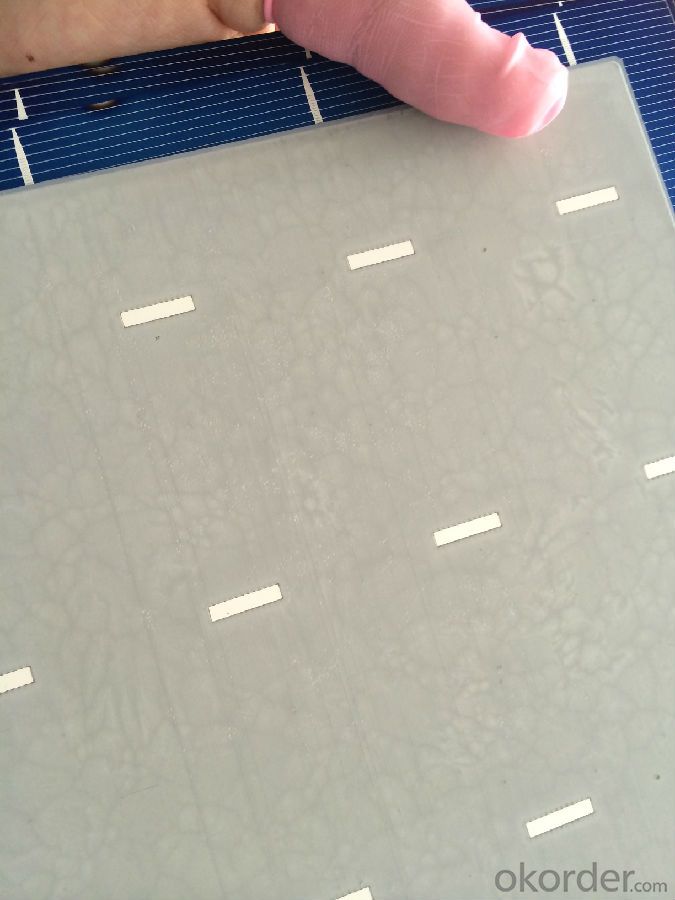


Electrical Characteristic
Efficiency (%) | Pmpp (W) | Umpp (V) | Impp (A) | Uoc (V) | Isc (A) | FF (%) |
17.25 | 4.197 | 0.524 | 7.992 | 0.62 | 8.458 | 80.03% |
17 | 4.137 | 0.524 | 7.876 | 0.619 | 8.353 | 80.01% |
16.75 | 4.076 | 0.522 | 7.81 | 0.617 | 8.286 | 79.73% |
16.5 | 4.015 | 0.518 | 7.746 | 0.613 | 8.215 | 79.73 |
16.25 | 3.955 | 0.515 | 7.683 | 0.61 | 8.144 | 79.61% |
16 | 3.894 | 0.512 | 7.613 | 0.608 | 8.075 | 79.31% |
15.75 | 3.833 | 0.51 | 7.534 | 0.605 | 8.058 | 78.62% |
15.5 | 3.772 | 0.508 | 7.453 | 0.604 | 8.02 | 77.87% |
15.25 | 3.771 | 0.505 | 7.35 | 0.604 | 9.997 | 76.83% |
15 | 3.65 | 0.503 | 7.271 | 0.604 | 7.989 | 75.64% |
14.5 | 3.529 | 0.499 | 7.067 | 0.604 | 7.988 | 73.14% |
14 | 3.407 | 0.499 | 6.833 | 0.604 | 7.833 | 72.01% |
Intensity Dependence
Intensity [W/m2] | Isc× [mA] | Voc× [mV] |
1000 | 1.00 | 1.000 |
900 | 0.90 | 0.989 |
500 | 0.50 | 0.963 |
300 | 0.30 | 0.939 |
200 | 0.20 | 0.920 |
Packaging & Delivery Of Poly Solar Cell 156mm | |
Packaging Detai | Packaging Detail:Export Carton and Pallet or under customer request. |
Delivery Detail:10-20days | |
FAQ
Q:What price for each watt?
A:It depends on the quantity, delivery date and payment terms
Q:What is your warranty system?
A:Our Solar cells performance guarantees for 25 years
Q:How do you pack your products?
A:We have rich experience on how to pack thecells to make sure the safety on shipment when it arrives at the destination.
Brief introduction of 4bb solar cell
4bb solar cells through the photoelectric effect or photochemical effect directly convert light into electrical energy, which makes use of the photoelectric conversion principle of solar radiation through the semiconductor material electrical energy transformed into a device; the photoelectric conversion process is usually called "photovoltaic hit "affect, therefore, solar cells, also known as" photovoltaic cells.
Working principle of 4bb solar cell
Foundation of working principle of 4bb solar cell is the "photovoltaic" effect semiconductor PN junction. The so-called photovoltaic effect, simply put, is that when the object is exposed to light, its charge distribution in vivo to produce an effect of EMF and current changes. In gases, liquids and solids can produce this effect, but in solid, especially in the semiconductor, solar energy is converted to electrical energy efficiency is particularly high, so the semiconductor photoelectric effect aroused special attention, the most studied, and invention of manufacturing a semiconductor solar cells.
When sun lights PN junction, the electrons in the semiconductor due to the availability of light energy and release electrons, and accordingly will produce electron - hole pairs, and the role of the barrier electric field, electrons are driven to the N-type region, holes are driven to the P-type region so that the region has a surplus of electrons N, P region has excess holes; so in the vicinity of the PN junction formed with the barrier electric field in the opposite direction of photo-generated electric field. Light green part of the field of offset barrier electric field, the rest of the P-type region is positively charged, N-type region is negatively charged; so he makes the force N region and a thin layer of P zone between the generation, namely "photovoltaic" electromotive force. When the external circuit is turned on, there will be power output.
This is the basic principle of the PN junction contact silicon 4bb solar cell power generation. If the dozens, hundreds of solar cells in series, in parallel become encapsulated solar cell module in the sunlight irradiation, the power can be obtained with a certain power output

- Q: Can solar cells be used in military vehicles?
- Yes, solar cells can be used in military vehicles. They can provide an alternative source of energy to power various systems and equipment, reducing reliance on traditional fuel sources and enabling greater operational flexibility and sustainability. Additionally, solar cells can help extend the range and endurance of military vehicles in remote or austere environments where access to conventional fuel supplies may be limited.
- Q: Can solar cells be used for powering remote sensors?
- Yes, solar cells can be used for powering remote sensors. Solar cells convert sunlight into electricity, making them an ideal power source for remote sensors in locations where access to a power grid is limited or non-existent. This enables continuous operation of the sensors without the need for frequent battery replacements, making solar cells an efficient and sustainable solution for powering remote sensors.
- Q: How do solar cells perform in areas with high levels of volcanic ash?
- Solar cells may not perform optimally in areas with high levels of volcanic ash. Volcanic ash can reduce the amount of sunlight reaching the solar cells, thereby decreasing their efficiency. Additionally, ash particles can settle on the surface of the solar panels, blocking sunlight and reducing their output further. Regular cleaning and maintenance may be required to ensure effective performance in such areas.
- Q: How do solar cells perform in areas with high levels of salt spray?
- Solar cells generally do not perform well in areas with high levels of salt spray. The salt particles can accumulate on the surface of the solar cells, reducing their efficiency by blocking sunlight and corroding the electrical components. Regular cleaning and maintenance are required to mitigate the negative impacts of salt spray on solar panels in such areas.
- Q: Can solar cells be used in medical devices?
- Yes, solar cells can be used in medical devices. They can be integrated into various medical devices such as implantable devices (pacemakers), wearable devices (fitness trackers), and portable devices (blood glucose monitors) to provide a sustainable and reliable source of power.
- Q: What is the lifespan of solar cells?
- The lifespan of solar cells typically varies between 25 to 30 years, although some high-quality panels can last up to 40 years with proper maintenance and care.
- Q: What is a good introduction of solar cell?
- A professional presentation will be very impressive.
- Q: Can solar cells be used in residential applications?
- Yes, solar cells can be used in residential applications. They are commonly used to generate electricity for homes by converting sunlight into electrical energy. This renewable energy source can help reduce reliance on traditional electricity grids, lower electricity bills, and contribute to a more sustainable and environmentally friendly lifestyle.
- Q: Can solar cells be used in disaster relief efforts?
- Yes, solar cells can be used in disaster relief efforts. They are a reliable and sustainable source of energy that can provide electricity in areas affected by natural disasters, where power grids may be damaged or non-existent. Solar cells can be used to power emergency lighting, communication systems, medical equipment, and water purification systems, among other essential needs. Additionally, solar energy can be harnessed to charge mobile devices and provide a means of communication and access to information during these critical times. Overall, solar cells are a valuable tool in disaster relief efforts, offering a clean and renewable energy solution to support affected communities.
- Q: How much land is required to install solar cells?
- The amount of land required to install solar cells depends on various factors such as the capacity of the solar system, efficiency of the solar panels, and the power generation goals. On average, it is estimated that a 1 MW solar power plant requires about 4-5 acres of land. However, with advancements in solar technology, the land requirements are decreasing as solar panels become more efficient and produce more power per square foot.
Send your message to us
Elon Musk Inspired Poly 3bb 4bb Solar Cells with Low Price 156*156mm
- Loading Port:
- Shanghai
- Payment Terms:
- TT or LC
- Min Order Qty:
- 30000 pc
- Supply Capability:
- 3000000 pc/month
OKorder Service Pledge
OKorder Financial Service
Similar products
Hot products
Hot Searches
Related keywords
